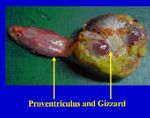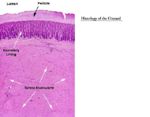Difference between revisions of "Gizzard - Anatomy & Physiology"
Jump to navigation
Jump to search
Fiorecastro (talk | contribs) |
m |
||
| (22 intermediate revisions by 8 users not shown) | |||
| Line 1: | Line 1: | ||
| − | {{ | + | {{toplink |
| + | |backcolour =BCED91 | ||
| + | |linkpage =Alimentary - Anatomy & Physiology | ||
| + | |linktext =Alimentary System | ||
| + | |maplink = Alimentary (Concept Map)- Anatomy & Physiology | ||
| + | |pagetype =Anatomy | ||
| + | |sublink1=Avian Digestive Tract - Anatomy & Physiology | ||
| + | |subtext1=AVIAN DIGESTIVE TRACT | ||
| + | }} | ||
| + | <br> | ||
| + | |||
==Introduction== | ==Introduction== | ||
| − | The gizzard is also referred to as the muscular stomach or | + | The gizzard is also referred to as the muscular stomach or ventriculus. It is connected by the isthmus to the [[The Proventriculus - Anatomy & Physiology|proventriculus]] and to the [[Duodenum - Anatomy & Physiology|duodenum]]. |
| + | |||
==Structure and Function== | ==Structure and Function== | ||
| − | [[Image:Gizzard Anatomy.jpg|thumb|right| | + | [[Image:Gizzard Anatomy.jpg|thumb|right|150px|Gizzard Anatomy - RVC 2008]] |
| − | + | *Mechanical reduction of tougher material through powerful muscular development | |
| − | The | + | *Cranial to the [[Avian Liver - Anatomy & Physiology|liver]] and [[Spleen - Anatomy & Physiology|spleen]] (contacts the [[Avian Liver - Anatomy & Physiology|liver]]) |
| + | |||
| + | *Contacts the sternum and lower left abdominal wall | ||
| + | |||
| + | *Dorsally the abdominal air sacs separate it from the intestines and gonads | ||
| + | |||
| + | *[[Duodenum - Anatomy & Physiology|Duodenum]] and [[Pancreas - Anatomy & Physiology|pancreas]] lies in its caudal right surface | ||
| + | |||
| + | *More caudal than the [[The Proventriculus - Anatomy & Physiology|proventriculus]] | ||
| + | |||
| + | *Roughly on the midline of the bird | ||
| + | |||
| + | *Lens shaped | ||
| + | |||
| + | *Interior elongated by cranial and caudal blind sacs | ||
| + | |||
| + | *Cranial blind sac contacts [[The Proventriculus - Anatomy & Physiology|proventriculus]] | ||
| + | |||
| + | *Pylorus on right surface next to cranial blind sac | ||
| + | |||
| + | *Two thick masses of muscle that insert on tendonous surfaces | ||
| + | |||
| + | *In seed eating birds grit is digested to increase grinding down of food particles | ||
| + | |||
| + | *Surface covered by glistening tendonous layer | ||
| + | |||
| + | *The cranial and caudal extremities are formed by powerful red muscular tissue | ||
| + | |||
| + | *A circular aponeurosis is present connecting the cranial end of the gizzard to the isthmus and the caudal end to the [[Duodenum - Anatomy & Physiology|duodenum]] | ||
| + | |||
| + | *Appears yellow due to bile reflux from the [[Duodenum - Anatomy & Physiology|duodenum]] | ||
| + | |||
| + | *When the thin muscles of the gizzard contract, food passes from the gizzard into the [[Duodenum - Anatomy & Physiology|duodenum]] | ||
| + | |||
| + | *When the thick muscles of the gizzard contract, food moves back into the [[The Proventriculus - Anatomy & Physiology|proventriculus]] | ||
| + | |||
| + | [[Image:Gizzard Histology.jpg|thumb|right|150px|Gizzard Histology- Dr. Thomas Caceci]] | ||
==Histology== | ==Histology== | ||
| − | |||
| − | |||
| − | + | *Thin, but tough mucous membrane | |
| + | |||
| + | *Pale, thin lining raised into ridges | ||
| + | |||
| + | *3 layers of lamina muscularis | ||
| + | |||
| + | *Cuboidal epithelium | ||
| + | |||
| + | *Tubular glands | ||
| + | |||
| + | *Cuticle of koilin a carbohydrate complex is present due to the solidifying of the glandular secretion. It is replenished as it is worn down. | ||
| + | |||
| + | *Thick keratin layer to protect muscle | ||
| + | |||
| + | |||
| + | ==Species Diffences== | ||
| + | |||
| + | *No gizzard in falconiformes (raptors etc.) | ||
| + | |||
| + | *No gizzard in stringiformes (owls etc.) | ||
| − | + | *No gizzard in gulls | |
| − | |||
==Other Information== | ==Other Information== | ||
| − | Grit should be provided in | + | *Grit should be provided in seed eating birds diet. It is radiodense and marks out where the gizzard is located on radiographs. |
| − | |||
| − | |||
| − | |||
| − | |||
| − | |||
| − | == | + | ==Links== |
| − | |||
| − | [[ | + | [[The Avian Alimentary Tract - Anatomy & Physiology - Flashcards|Avian Alimentary Tract Flashcards]] |
| − | |||
Revision as of 22:05, 2 September 2008
|
|
Introduction
The gizzard is also referred to as the muscular stomach or ventriculus. It is connected by the isthmus to the proventriculus and to the duodenum.
Structure and Function
- Mechanical reduction of tougher material through powerful muscular development
- Contacts the sternum and lower left abdominal wall
- Dorsally the abdominal air sacs separate it from the intestines and gonads
- More caudal than the proventriculus
- Roughly on the midline of the bird
- Lens shaped
- Interior elongated by cranial and caudal blind sacs
- Cranial blind sac contacts proventriculus
- Pylorus on right surface next to cranial blind sac
- Two thick masses of muscle that insert on tendonous surfaces
- In seed eating birds grit is digested to increase grinding down of food particles
- Surface covered by glistening tendonous layer
- The cranial and caudal extremities are formed by powerful red muscular tissue
- A circular aponeurosis is present connecting the cranial end of the gizzard to the isthmus and the caudal end to the duodenum
- Appears yellow due to bile reflux from the duodenum
- When the thin muscles of the gizzard contract, food passes from the gizzard into the duodenum
- When the thick muscles of the gizzard contract, food moves back into the proventriculus
Histology
- Thin, but tough mucous membrane
- Pale, thin lining raised into ridges
- 3 layers of lamina muscularis
- Cuboidal epithelium
- Tubular glands
- Cuticle of koilin a carbohydrate complex is present due to the solidifying of the glandular secretion. It is replenished as it is worn down.
- Thick keratin layer to protect muscle
Species Diffences
- No gizzard in falconiformes (raptors etc.)
- No gizzard in stringiformes (owls etc.)
- No gizzard in gulls
Other Information
- Grit should be provided in seed eating birds diet. It is radiodense and marks out where the gizzard is located on radiographs.

